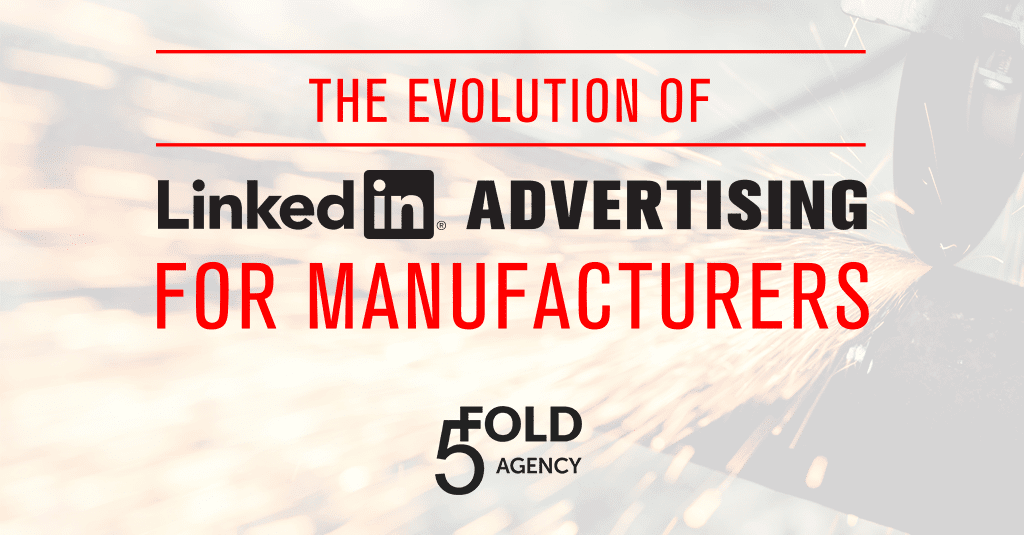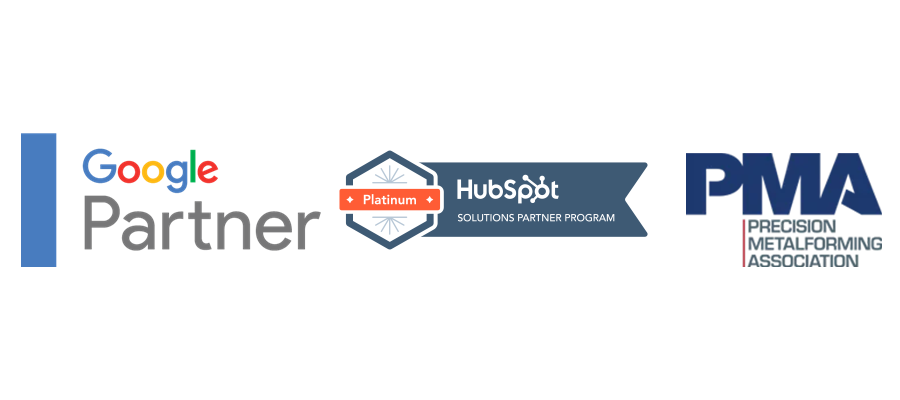
The Evolution of LinkedIn Advertising for Manufacturers
How can LinkedIn advertising produce the best ROI?
Before you can look at the specific tactics for LinkedIn, you first need to take a step back and look at the historical advertising trends and tactics that companies have used for years. From an advertising stance, there are several different traditional advertising categories used by manufacturers:
PPC Campaigns – Google AdWords campaigns.
Trade Shows – If trade show advertising is done correctly and if your company is the right fit, then a trade show can produce decent ROI.
Print Advertising – Magazines that go out to a specific OEM database, something that engineers and purchasers at OEMs read.
Online Banner Ads – Ads on Google or associate companies and affiliate company websites, whether they’re associations, trade shows, etc.
Direct Mail Advertising – Easy and cost-effective.
What a lot of companies don’t do when looking at their advertising strategy is adapt to changes in the market and watch where the OEMs are focusing their attention. Manufacturing companies are using outdated tactics and outdated advertisements on platforms that are not producing the ROI. The market is not there to give them what they’re looking for, but they are used to this result. Manufacturing is a slow industry to adapt to marketing changes, and they tend to have a muscle memory and stick with what previously worked. They also tend to rely on agencies that don’t have specific experience in the manufacturing environment and can’t properly direct them to where they should spend their money. If you talk to a trade show company, they’re going to pitch on why you should advertise with them. If you talk to a general marketing agency, they’re going to pitch why you need Google AdWords or Facebook advertising because that’s what they do for other companies. For manufacturing specifically, LinkedIn has made leaps and bounds with the general B2B marketing audience. All we’ve done is take that specific strategy and what they have available and applied it in the most effective way for manufacturing companies.
LinkedIn sponsored posts are the most effective form of advertising on LinkedIn. Originally, companies that ran a PPC campaign on LinkedIn had to pay $20,000 a quarter to qualify for LinkedIn’s advertising program with sponsored posts. This means they had to spend $20,000 on their cost per click on a quarterly basis.
A Strategic Change
Around January 2016 LinkedIn made a very wise and strategic change to its advertising platform. They opened up their sponsored posts, advertising, and in-mail to what is called a “self-serve”. This meant that any company, regardless of what they are going to spend, whether it’s $5 or $50,000 a month, could now fully utilize LinkedIn advertising. Companies now have their own access to all advertising aspects and can set bit strategies for their target demographic, pause and stop campaigns, and pick their bid budgets.
When LinkedIn opened up its advertising roughly two years ago, we jumped right in to determine if it was effective. What we quickly discovered, and continue to find, is LinkedIn is the most effective way for manufacturing companies to advertise. LinkedIn is continuously evolving and making improvements to the campaign platform resulting in advertising that is more strategic and targeted than it was two years prior.
LinkedIn has proven benefits and has evolved to be the number one advertising spot for manufacturing companies. Approximately 75% of the companies manufacturers are trying to target are on LinkedIn in some fashion. Even if a company doesn’t have its own page their employees tend to have LinkedIn pages. Now what it comes down to is how frequently these companies are accessing LinkedIn. This number is increasing every year as they improve the platform, in fact, it’s estimated that there are 2 new LinkedIn users per second. Currently, there are about 500 million users and about 250 million monthly users. What we see is that people are no longer using the platform strictly as a better Monster.com for job searching. A lot of people who have profiles on LinkedIn also have profiles on Facebook, but the purpose for each is different. On LinkedIn, you’re going to get less personal stories and more focus on career and business, and you have total control over your privacy and settings.
If your target demographic is on LinkedIn, then using the platform for sponsored posts gives you 100% control over who sees your posts, how often they see your posts, and where they see your posts. Maybe you have a list of company names that you’re trying to prospect. These are people you’re reaching out to on a weekly or monthly basis trying to get RFQs from, or maybe you didn’t follow up enough with them or quoted them two years ago, and you’re wanting to get back in front of them. A proper sales strategy should be monitoring and tracking who you’re going after, and continuously following up with them using different sales tactics. If you have that in place, then you already know who to target with a LinkedIn campaign. LinkedIn allows you to have up to 100 targeted companies per campaign. For instance, if you are a plastics company and you’re looking for people in biotechnology, medical devices, automotive, industrial electronics, or consumer electronics, then you have a list of companies you can set your campaign to target only those companies.
To narrow your target demographic down further, you can get to the actual profiles of specific people within those companies. You can go after their job functions—operations, purchasing, engineering, sales, marketing, etc. Then you can type in the specific title for those positions. For example, if you want to target commodity managers, product development engineers, buyers, or VP, then the platform tells you how many people come back on that search based on what you’re looking for. You can also narrow down your target demographic based on the geographic location.
The platform offers precise targeting and strategic focus on who sees your campaign, and this is how LinkedIn can justify the higher cost per click, which is going to range between $8 and $15 to get to the top of someone’s feed. If you’re only willing to pay $3 per click you’re not going to get to the top of your target’s feed and the target would have to scroll down their feed a decent amount before reaching your ad, and essentially that’s a waste of money. If you set up the strategies and the campaigns to target the most effective audience then you want to show up first, so spend the extra money. If your target has an interest or a need they will click your advertisement because you’ve been strategic and taken the guesswork out of their decision.
A lot of manufacturing companies use Google AdWords PPC, and with this advertising option you have no control over what we call “the intent of search”. Just because someone is searching a phrase that you’re running an ad against does not mean that they are a buyer. This wasted click could be a competitor, a researcher, someone trying to knock off your process or technology, or data scrapers that are trying to sell you a service. With LinkedIn sponsored posts, you get 100% control. Of course, there are times when someone clicks your link in an ad and they go to your site, and it’s not a good fit. This goes back to the creative side of advertising and how your ad was created.
Analyze The Data
You have to make sure your ad is properly conveying your message and not just generalized to get clicks because then your bounce rate is going to be high. Paying attention to the bounce rate of your referral traffic from LinkedIn is going to qualify and quantify the effectiveness of your LinkedIn campaigns. For instance, if people are coming to your site from LinkedIn campaigns and your bounce rate is at 95% then it is not as effective as it should be. Honestly, you should be seeing bounce rates that are around 60% or less, but ideally between 40-70% at the high end. Next, you want to look at your click-through rate, which is the ratio of users who click on a campaign link to the number of total users viewing your campaign.
You want to analyze both your bounce rate and your click-through rate on LinkedIn through the campaign platform. LinkedIn’s most recently published information says a good click-through rate is around .35%, but in our opinion, that’s not accurate. Most of our client’s campaigns are seeing .75-1.4% click-through rates because we know what we’re doing and we’re hyper-focused and strategic with our campaigns. With our background in manufacturing, our clients are seeing a higher ROI. You can’t just know the LinkedIn platform; you have to understand the target demographic as well.
LinkedIn advertising has evolved to allow manufacturing companies to get their content and increase their brand awareness in front of the most strategic and focused group of people. You’re no longer relying on your target demographic to see your ad in a magazine, email, or other campaigns. You have control over the effectiveness of your campaign and the data to support it versus the print side which can’t quantify how many people have seen your print ad. Even if you look at online magazines, they’re going to give you stats on how many people viewed your campaign or how many impressions the site had, but this data will not be specific to your page. If online magazines had to provide that data they’d prove how ineffective their campaigns are in comparison to LinkedIn.
The percentage of people who are using this LinkedIn tactic is currently very low because most manufacturing companies that are repeatedly using LinkedIn advertising are our clients. They see the effectiveness of this form of advertising, and we’ve proven that it can produce a better ROI than other tactics. You have to adjust and evolve to where your target demographic is placing their attention, and it’s not as effective in traditional places anymore. They’ve shifted their attention to more social means, and that’s the most effective and efficient way to reach them. You put your advertisement in front of their feed and if they’re interested they’ll click. It’s aggressive to get it in front of them, but you’re not hounding them to click, the decision is up to them. These types of campaigns aren’t something they’re typically seeing, but it’s something that when they do see it, they know it’s speaking directly to them. This piques their interest to at least click and view your LinkedIn page and see who is targeting them. Eventually, when marketers dilute the market, and everyone is doing this, then the attention is going to dwindle, and the value is going to be less. As long as the cost doesn’t increase, stays the same, or gets less, then this will still be a solid platform to market to.
We see a lot of people making mistakes with LinkedIn advertising. They test it out and they throw $500 at a campaign, but they don’t optimize it. They aren’t going after a specific function, job title, or company. They also don’t create custom graphics to grab their prospect’s attention. A professional graphic is necessary, and even though LinkedIn has slightly different specs, we have discovered that 1024 x 535 is the best size for advertising graphics on LinkedIn. Most companies don’t have the correct size or they don’t have a custom graphic at all because they don’t have designers on staff. After launching their campaign nothing really happens because they are just sending traffic to their homepage, which isn’t very effective. Then these companies have a bad taste in their mouth for LinkedIn advertising.
LinkedIn Advertising Tips
Here are some tips that we suggest to anyone in the manufacturing space to utilize on LinkedIn.
- Narrow Your Target
Your target demographic needs to be as specific as possible. Use all of the filtering fields to yield the most effective results (title, job function, industry, groups, seniority). The title filter allows you to narrow down your audience to the exact decision-makers. If your results are too limited, then use the Job Function filter instead. - Content Relevancy Matters
Generic content or graphics won’t produce results. Develop highly specific content and graphics and run micro-campaigns to a very niche audience. Your ad graphic and the copy must catch your audience’s attention, but it also must be relevant to their needs. If you don’t know what your audience wants to see, then do some research before running campaigns. Keep in mind—what you think is relevant isn’t always what your audience thinks is relevant. - Landing Page is Key
A common mistake we see all the time is running campaigns that point the audience on a home page instead of a landing page. Your audience won’t know what action you want them to take when you dump them on a home page. Instead, your ads should direct your audience to an internal landing page with a targeted, specific call to action. The look and feel of the landing page should match the ad graphic and copy. Don’t let all the time and money you’ve spent on advertising go to waste—corresponding landing pages are the best way to minimize your bounce rate and maximize your ROI. - The “See More” Will Kill You
Once an ad exceeds 130 characters of text, the “see more” grey text appears on the mobile view. Users have to click “see more” to read the rest of the text. This causes accidental clicks (which can add up to serious cash), and people will bounce right away. Keep your ad copy simple and under 130 characters. - Monitor Your Bounce Rate
You sent traffic to your site, but how closely are you monitoring the bounce rate? The bounce rate is the fastest way to gauge the effectiveness of your advertising campaign. When starting new campaigns, you have to monitor this daily to avoid wasting money. If your bounce rate is greater than 60%, you need to revisit your target demographic criteria, ad graphic, ad copy, and landing page. Once your bounce rate is lower than 60%, it’s OK to reduce monitoring to every other day. - Start with Four Ads
Make sure that all sponsored posts include four ads. If your audience doesn’t click your ad the first time, they will see your ad again. If you only have one or two available ads, your audience will keep seeing the same ad over and over. This can cause ad blindness (they don’t even notice the ad anymore) or even cause them to be annoyed by your brand. If your audience doesn’t click your ad the first or second time it appears in their feed, then the ad isn’t catching their attention. If you have four ads in rotation, you can test different graphics and copy to determine what resonates with your audience.
At the end of the day, if you’re willing to spend the money to run effective LinkedIn campaigns and monitor those campaigns you can land interest that could result in hundreds of thousands of dollars, if not millions of dollars, in sales by initiating engagement, contacts, and conversations through LinkedIn sponsored posts. LinkedIn as a whole has evolved from a place where people go to find a job to a news source, to connect and network, consume content, and share stories on a personal and professional level. LinkedIn is the Facebook of business. While Facebook does make sense for marketing campaigns if you’re a specific type of business, for B2B, especially manufacturing, you cannot beat the effectiveness of LinkedIn.

Kyle Milan is a well accomplished Industrial/Manufacturing sales and marketing professional with over 20 years of experience. He is the CEO of MFG Tribe (Industrial Marketing Agency) and Technical Sales University (https://technicalsalesu.com) and is considered the leader of Sales and Marketing Strategy & Social Media Marketing for industrial companies. He has published several articles in major news media outlets on various topics of; Inbound Marketing, Digital Marketing, Social Media Marketing & Advertising, Industrial Marketing, Manufacturing Marketing, and Entrepreneurship.




